PPMP20011: Queensland Health Payroll Program Negotiation Report
VerifiedAdded on 2020/03/13
|6
|1649
|48
Report
AI Summary
This report, focused on the Queensland Health Payroll Program, examines negotiation and conflict resolution within the context of four key projects: forward strategy, governance, people and change, and funding. It details the characteristics of each project, including novelty, complexity, and uncertainty, and analyzes the negotiating positions and potential conflicts of owners, designers, and contractors. The report recommends interaction and communication as vital negotiation processes, and suggests specific negotiation methods such as integrated design and project teams, tailored to each project's needs. Furthermore, it outlines the preferred procurement outcomes, including RFx processes, various governance models, and different procurement forms like traditional and alliance approaches, along with funding strategies. The report emphasizes the importance of clear communication, common interests, and well-defined financial planning to achieve successful project outcomes and avoid conflicts.
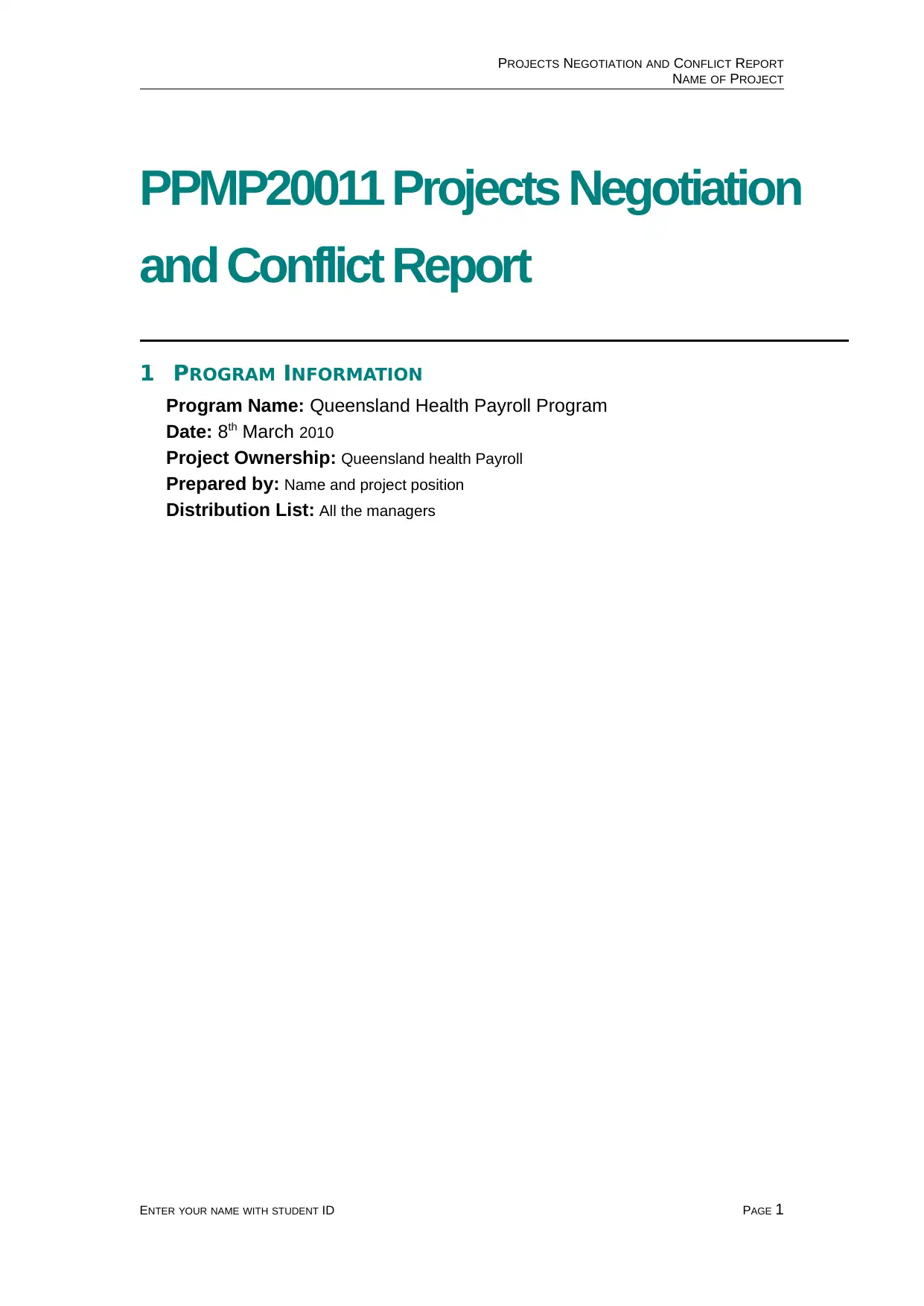
PROJECTS NEGOTIATION AND CONFLICT REPORT
NAME OF PROJECT
PPMP20011 Projects Negotiation
and Conflict Report
1 PROGRAM INFORMATION
Program Name: Queensland Health Payroll Program
Date: 8th March 2010
Project Ownership: Queensland health Payroll
Prepared by: Name and project position
Distribution List: All the managers
ENTER YOUR NAME WITH STUDENT ID PAGE 1
NAME OF PROJECT
PPMP20011 Projects Negotiation
and Conflict Report
1 PROGRAM INFORMATION
Program Name: Queensland Health Payroll Program
Date: 8th March 2010
Project Ownership: Queensland health Payroll
Prepared by: Name and project position
Distribution List: All the managers
ENTER YOUR NAME WITH STUDENT ID PAGE 1
Paraphrase This Document
Need a fresh take? Get an instant paraphrase of this document with our AI Paraphraser
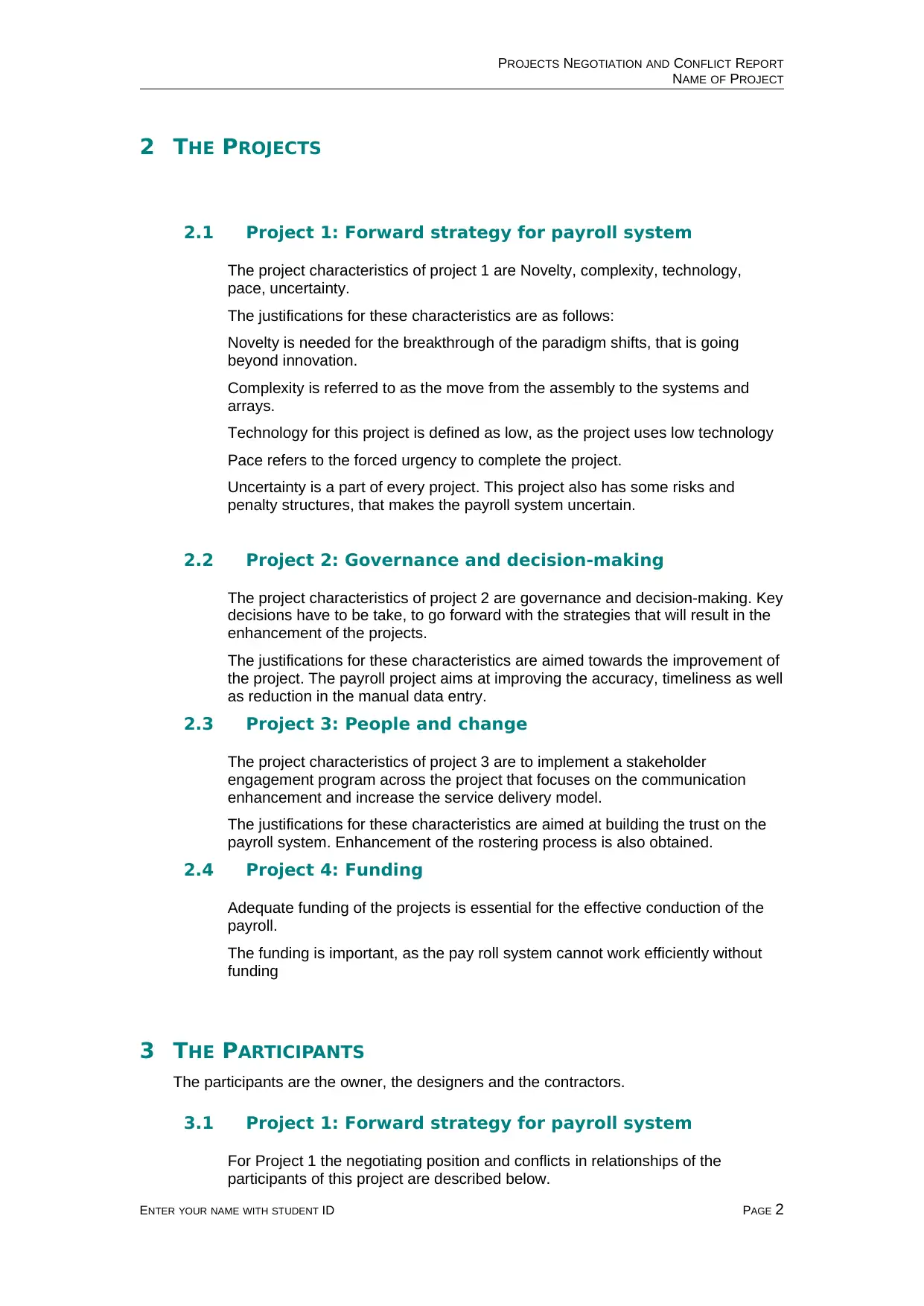
PROJECTS NEGOTIATION AND CONFLICT REPORT
NAME OF PROJECT
2 THE PROJECTS
2.1 Project 1: Forward strategy for payroll system
The project characteristics of project 1 are Novelty, complexity, technology,
pace, uncertainty.
The justifications for these characteristics are as follows:
Novelty is needed for the breakthrough of the paradigm shifts, that is going
beyond innovation.
Complexity is referred to as the move from the assembly to the systems and
arrays.
Technology for this project is defined as low, as the project uses low technology
Pace refers to the forced urgency to complete the project.
Uncertainty is a part of every project. This project also has some risks and
penalty structures, that makes the payroll system uncertain.
2.2 Project 2: Governance and decision-making
The project characteristics of project 2 are governance and decision-making. Key
decisions have to be take, to go forward with the strategies that will result in the
enhancement of the projects.
The justifications for these characteristics are aimed towards the improvement of
the project. The payroll project aims at improving the accuracy, timeliness as well
as reduction in the manual data entry.
2.3 Project 3: People and change
The project characteristics of project 3 are to implement a stakeholder
engagement program across the project that focuses on the communication
enhancement and increase the service delivery model.
The justifications for these characteristics are aimed at building the trust on the
payroll system. Enhancement of the rostering process is also obtained.
2.4 Project 4: Funding
Adequate funding of the projects is essential for the effective conduction of the
payroll.
The funding is important, as the pay roll system cannot work efficiently without
funding
3 THE PARTICIPANTS
The participants are the owner, the designers and the contractors.
3.1 Project 1: Forward strategy for payroll system
For Project 1 the negotiating position and conflicts in relationships of the
participants of this project are described below.
ENTER YOUR NAME WITH STUDENT ID PAGE 2
NAME OF PROJECT
2 THE PROJECTS
2.1 Project 1: Forward strategy for payroll system
The project characteristics of project 1 are Novelty, complexity, technology,
pace, uncertainty.
The justifications for these characteristics are as follows:
Novelty is needed for the breakthrough of the paradigm shifts, that is going
beyond innovation.
Complexity is referred to as the move from the assembly to the systems and
arrays.
Technology for this project is defined as low, as the project uses low technology
Pace refers to the forced urgency to complete the project.
Uncertainty is a part of every project. This project also has some risks and
penalty structures, that makes the payroll system uncertain.
2.2 Project 2: Governance and decision-making
The project characteristics of project 2 are governance and decision-making. Key
decisions have to be take, to go forward with the strategies that will result in the
enhancement of the projects.
The justifications for these characteristics are aimed towards the improvement of
the project. The payroll project aims at improving the accuracy, timeliness as well
as reduction in the manual data entry.
2.3 Project 3: People and change
The project characteristics of project 3 are to implement a stakeholder
engagement program across the project that focuses on the communication
enhancement and increase the service delivery model.
The justifications for these characteristics are aimed at building the trust on the
payroll system. Enhancement of the rostering process is also obtained.
2.4 Project 4: Funding
Adequate funding of the projects is essential for the effective conduction of the
payroll.
The funding is important, as the pay roll system cannot work efficiently without
funding
3 THE PARTICIPANTS
The participants are the owner, the designers and the contractors.
3.1 Project 1: Forward strategy for payroll system
For Project 1 the negotiating position and conflicts in relationships of the
participants of this project are described below.
ENTER YOUR NAME WITH STUDENT ID PAGE 2
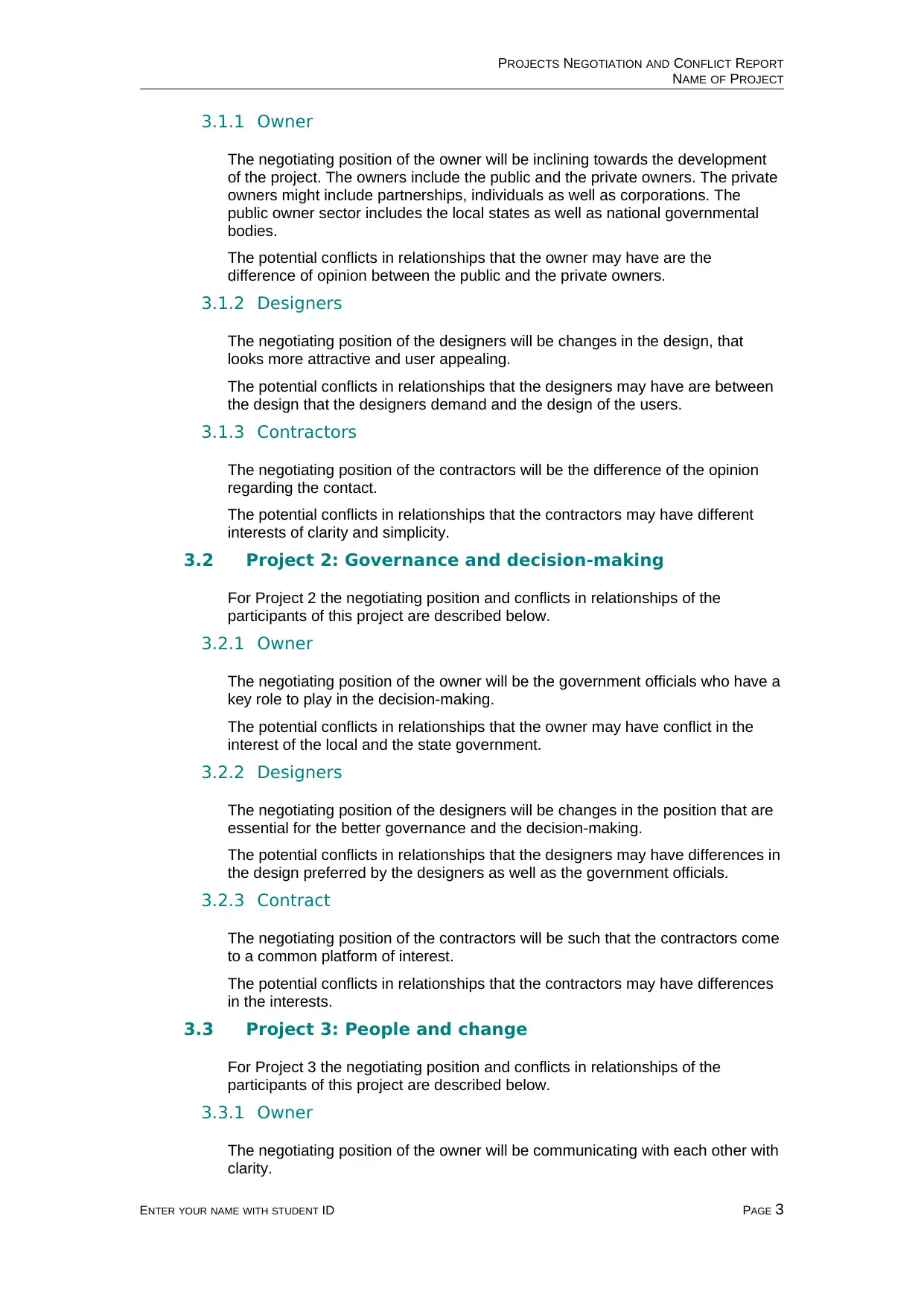
PROJECTS NEGOTIATION AND CONFLICT REPORT
NAME OF PROJECT
3.1.1 Owner
The negotiating position of the owner will be inclining towards the development
of the project. The owners include the public and the private owners. The private
owners might include partnerships, individuals as well as corporations. The
public owner sector includes the local states as well as national governmental
bodies.
The potential conflicts in relationships that the owner may have are the
difference of opinion between the public and the private owners.
3.1.2 Designers
The negotiating position of the designers will be changes in the design, that
looks more attractive and user appealing.
The potential conflicts in relationships that the designers may have are between
the design that the designers demand and the design of the users.
3.1.3 Contractors
The negotiating position of the contractors will be the difference of the opinion
regarding the contact.
The potential conflicts in relationships that the contractors may have different
interests of clarity and simplicity.
3.2 Project 2: Governance and decision-making
For Project 2 the negotiating position and conflicts in relationships of the
participants of this project are described below.
3.2.1 Owner
The negotiating position of the owner will be the government officials who have a
key role to play in the decision-making.
The potential conflicts in relationships that the owner may have conflict in the
interest of the local and the state government.
3.2.2 Designers
The negotiating position of the designers will be changes in the position that are
essential for the better governance and the decision-making.
The potential conflicts in relationships that the designers may have differences in
the design preferred by the designers as well as the government officials.
3.2.3 Contract
The negotiating position of the contractors will be such that the contractors come
to a common platform of interest.
The potential conflicts in relationships that the contractors may have differences
in the interests.
3.3 Project 3: People and change
For Project 3 the negotiating position and conflicts in relationships of the
participants of this project are described below.
3.3.1 Owner
The negotiating position of the owner will be communicating with each other with
clarity.
ENTER YOUR NAME WITH STUDENT ID PAGE 3
NAME OF PROJECT
3.1.1 Owner
The negotiating position of the owner will be inclining towards the development
of the project. The owners include the public and the private owners. The private
owners might include partnerships, individuals as well as corporations. The
public owner sector includes the local states as well as national governmental
bodies.
The potential conflicts in relationships that the owner may have are the
difference of opinion between the public and the private owners.
3.1.2 Designers
The negotiating position of the designers will be changes in the design, that
looks more attractive and user appealing.
The potential conflicts in relationships that the designers may have are between
the design that the designers demand and the design of the users.
3.1.3 Contractors
The negotiating position of the contractors will be the difference of the opinion
regarding the contact.
The potential conflicts in relationships that the contractors may have different
interests of clarity and simplicity.
3.2 Project 2: Governance and decision-making
For Project 2 the negotiating position and conflicts in relationships of the
participants of this project are described below.
3.2.1 Owner
The negotiating position of the owner will be the government officials who have a
key role to play in the decision-making.
The potential conflicts in relationships that the owner may have conflict in the
interest of the local and the state government.
3.2.2 Designers
The negotiating position of the designers will be changes in the position that are
essential for the better governance and the decision-making.
The potential conflicts in relationships that the designers may have differences in
the design preferred by the designers as well as the government officials.
3.2.3 Contract
The negotiating position of the contractors will be such that the contractors come
to a common platform of interest.
The potential conflicts in relationships that the contractors may have differences
in the interests.
3.3 Project 3: People and change
For Project 3 the negotiating position and conflicts in relationships of the
participants of this project are described below.
3.3.1 Owner
The negotiating position of the owner will be communicating with each other with
clarity.
ENTER YOUR NAME WITH STUDENT ID PAGE 3
⊘ This is a preview!⊘
Do you want full access?
Subscribe today to unlock all pages.

Trusted by 1+ million students worldwide
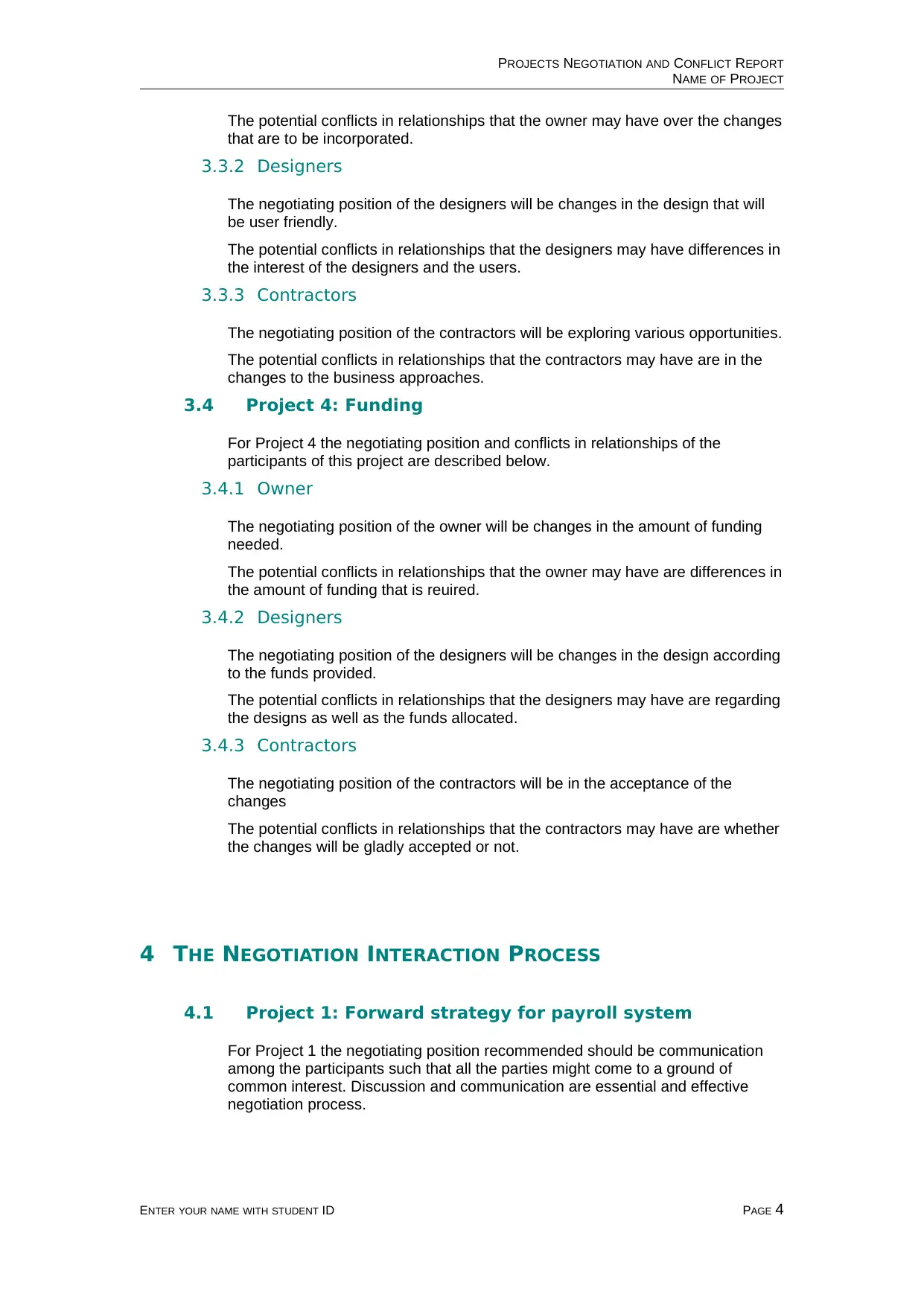
PROJECTS NEGOTIATION AND CONFLICT REPORT
NAME OF PROJECT
The potential conflicts in relationships that the owner may have over the changes
that are to be incorporated.
3.3.2 Designers
The negotiating position of the designers will be changes in the design that will
be user friendly.
The potential conflicts in relationships that the designers may have differences in
the interest of the designers and the users.
3.3.3 Contractors
The negotiating position of the contractors will be exploring various opportunities.
The potential conflicts in relationships that the contractors may have are in the
changes to the business approaches.
3.4 Project 4: Funding
For Project 4 the negotiating position and conflicts in relationships of the
participants of this project are described below.
3.4.1 Owner
The negotiating position of the owner will be changes in the amount of funding
needed.
The potential conflicts in relationships that the owner may have are differences in
the amount of funding that is reuired.
3.4.2 Designers
The negotiating position of the designers will be changes in the design according
to the funds provided.
The potential conflicts in relationships that the designers may have are regarding
the designs as well as the funds allocated.
3.4.3 Contractors
The negotiating position of the contractors will be in the acceptance of the
changes
The potential conflicts in relationships that the contractors may have are whether
the changes will be gladly accepted or not.
4 THE NEGOTIATION INTERACTION PROCESS
4.1 Project 1: Forward strategy for payroll system
For Project 1 the negotiating position recommended should be communication
among the participants such that all the parties might come to a ground of
common interest. Discussion and communication are essential and effective
negotiation process.
ENTER YOUR NAME WITH STUDENT ID PAGE 4
NAME OF PROJECT
The potential conflicts in relationships that the owner may have over the changes
that are to be incorporated.
3.3.2 Designers
The negotiating position of the designers will be changes in the design that will
be user friendly.
The potential conflicts in relationships that the designers may have differences in
the interest of the designers and the users.
3.3.3 Contractors
The negotiating position of the contractors will be exploring various opportunities.
The potential conflicts in relationships that the contractors may have are in the
changes to the business approaches.
3.4 Project 4: Funding
For Project 4 the negotiating position and conflicts in relationships of the
participants of this project are described below.
3.4.1 Owner
The negotiating position of the owner will be changes in the amount of funding
needed.
The potential conflicts in relationships that the owner may have are differences in
the amount of funding that is reuired.
3.4.2 Designers
The negotiating position of the designers will be changes in the design according
to the funds provided.
The potential conflicts in relationships that the designers may have are regarding
the designs as well as the funds allocated.
3.4.3 Contractors
The negotiating position of the contractors will be in the acceptance of the
changes
The potential conflicts in relationships that the contractors may have are whether
the changes will be gladly accepted or not.
4 THE NEGOTIATION INTERACTION PROCESS
4.1 Project 1: Forward strategy for payroll system
For Project 1 the negotiating position recommended should be communication
among the participants such that all the parties might come to a ground of
common interest. Discussion and communication are essential and effective
negotiation process.
ENTER YOUR NAME WITH STUDENT ID PAGE 4
Paraphrase This Document
Need a fresh take? Get an instant paraphrase of this document with our AI Paraphraser
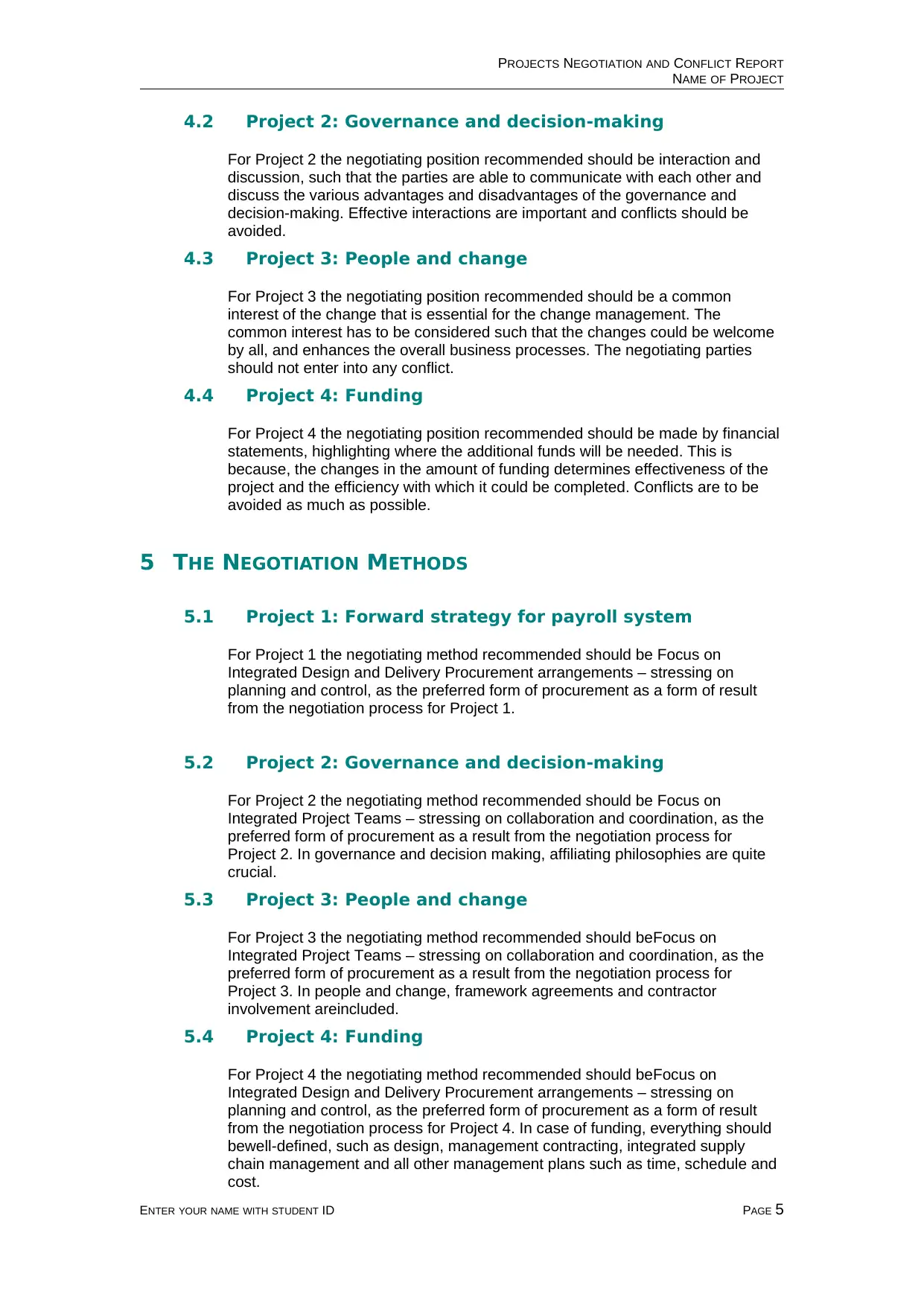
PROJECTS NEGOTIATION AND CONFLICT REPORT
NAME OF PROJECT
4.2 Project 2: Governance and decision-making
For Project 2 the negotiating position recommended should be interaction and
discussion, such that the parties are able to communicate with each other and
discuss the various advantages and disadvantages of the governance and
decision-making. Effective interactions are important and conflicts should be
avoided.
4.3 Project 3: People and change
For Project 3 the negotiating position recommended should be a common
interest of the change that is essential for the change management. The
common interest has to be considered such that the changes could be welcome
by all, and enhances the overall business processes. The negotiating parties
should not enter into any conflict.
4.4 Project 4: Funding
For Project 4 the negotiating position recommended should be made by financial
statements, highlighting where the additional funds will be needed. This is
because, the changes in the amount of funding determines effectiveness of the
project and the efficiency with which it could be completed. Conflicts are to be
avoided as much as possible.
5 THE NEGOTIATION METHODS
5.1 Project 1: Forward strategy for payroll system
For Project 1 the negotiating method recommended should be Focus on
Integrated Design and Delivery Procurement arrangements – stressing on
planning and control, as the preferred form of procurement as a form of result
from the negotiation process for Project 1.
5.2 Project 2: Governance and decision-making
For Project 2 the negotiating method recommended should be Focus on
Integrated Project Teams – stressing on collaboration and coordination, as the
preferred form of procurement as a result from the negotiation process for
Project 2. In governance and decision making, affiliating philosophies are quite
crucial.
5.3 Project 3: People and change
For Project 3 the negotiating method recommended should beFocus on
Integrated Project Teams – stressing on collaboration and coordination, as the
preferred form of procurement as a result from the negotiation process for
Project 3. In people and change, framework agreements and contractor
involvement areincluded.
5.4 Project 4: Funding
For Project 4 the negotiating method recommended should beFocus on
Integrated Design and Delivery Procurement arrangements – stressing on
planning and control, as the preferred form of procurement as a form of result
from the negotiation process for Project 4. In case of funding, everything should
bewell-defined, such as design, management contracting, integrated supply
chain management and all other management plans such as time, schedule and
cost.
ENTER YOUR NAME WITH STUDENT ID PAGE 5
NAME OF PROJECT
4.2 Project 2: Governance and decision-making
For Project 2 the negotiating position recommended should be interaction and
discussion, such that the parties are able to communicate with each other and
discuss the various advantages and disadvantages of the governance and
decision-making. Effective interactions are important and conflicts should be
avoided.
4.3 Project 3: People and change
For Project 3 the negotiating position recommended should be a common
interest of the change that is essential for the change management. The
common interest has to be considered such that the changes could be welcome
by all, and enhances the overall business processes. The negotiating parties
should not enter into any conflict.
4.4 Project 4: Funding
For Project 4 the negotiating position recommended should be made by financial
statements, highlighting where the additional funds will be needed. This is
because, the changes in the amount of funding determines effectiveness of the
project and the efficiency with which it could be completed. Conflicts are to be
avoided as much as possible.
5 THE NEGOTIATION METHODS
5.1 Project 1: Forward strategy for payroll system
For Project 1 the negotiating method recommended should be Focus on
Integrated Design and Delivery Procurement arrangements – stressing on
planning and control, as the preferred form of procurement as a form of result
from the negotiation process for Project 1.
5.2 Project 2: Governance and decision-making
For Project 2 the negotiating method recommended should be Focus on
Integrated Project Teams – stressing on collaboration and coordination, as the
preferred form of procurement as a result from the negotiation process for
Project 2. In governance and decision making, affiliating philosophies are quite
crucial.
5.3 Project 3: People and change
For Project 3 the negotiating method recommended should beFocus on
Integrated Project Teams – stressing on collaboration and coordination, as the
preferred form of procurement as a result from the negotiation process for
Project 3. In people and change, framework agreements and contractor
involvement areincluded.
5.4 Project 4: Funding
For Project 4 the negotiating method recommended should beFocus on
Integrated Design and Delivery Procurement arrangements – stressing on
planning and control, as the preferred form of procurement as a form of result
from the negotiation process for Project 4. In case of funding, everything should
bewell-defined, such as design, management contracting, integrated supply
chain management and all other management plans such as time, schedule and
cost.
ENTER YOUR NAME WITH STUDENT ID PAGE 5
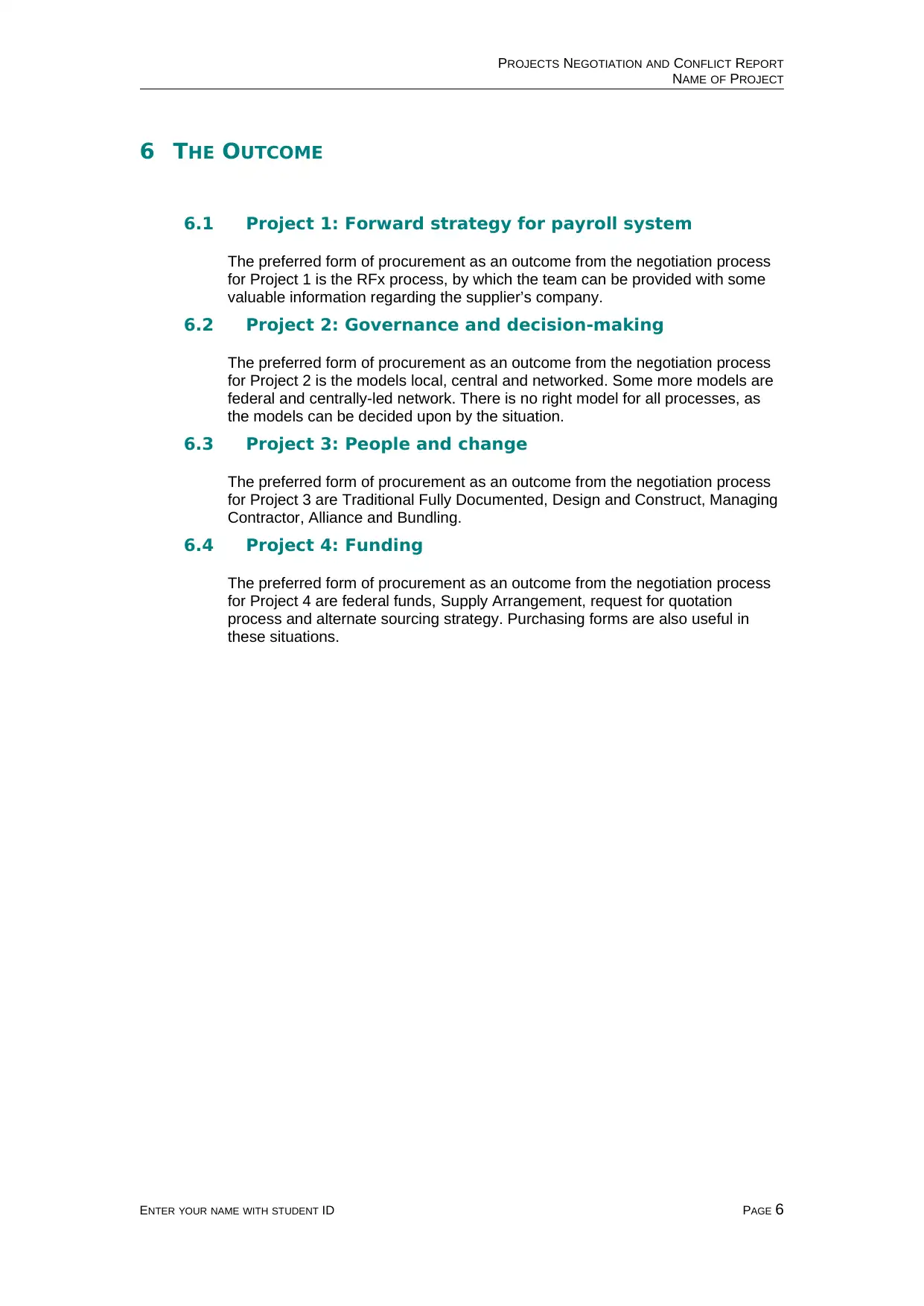
PROJECTS NEGOTIATION AND CONFLICT REPORT
NAME OF PROJECT
6 THE OUTCOME
6.1 Project 1: Forward strategy for payroll system
The preferred form of procurement as an outcome from the negotiation process
for Project 1 is the RFx process, by which the team can be provided with some
valuable information regarding the supplier’s company.
6.2 Project 2: Governance and decision-making
The preferred form of procurement as an outcome from the negotiation process
for Project 2 is the models local, central and networked. Some more models are
federal and centrally-led network. There is no right model for all processes, as
the models can be decided upon by the situation.
6.3 Project 3: People and change
The preferred form of procurement as an outcome from the negotiation process
for Project 3 are Traditional Fully Documented, Design and Construct, Managing
Contractor, Alliance and Bundling.
6.4 Project 4: Funding
The preferred form of procurement as an outcome from the negotiation process
for Project 4 are federal funds, Supply Arrangement, request for quotation
process and alternate sourcing strategy. Purchasing forms are also useful in
these situations.
ENTER YOUR NAME WITH STUDENT ID PAGE 6
NAME OF PROJECT
6 THE OUTCOME
6.1 Project 1: Forward strategy for payroll system
The preferred form of procurement as an outcome from the negotiation process
for Project 1 is the RFx process, by which the team can be provided with some
valuable information regarding the supplier’s company.
6.2 Project 2: Governance and decision-making
The preferred form of procurement as an outcome from the negotiation process
for Project 2 is the models local, central and networked. Some more models are
federal and centrally-led network. There is no right model for all processes, as
the models can be decided upon by the situation.
6.3 Project 3: People and change
The preferred form of procurement as an outcome from the negotiation process
for Project 3 are Traditional Fully Documented, Design and Construct, Managing
Contractor, Alliance and Bundling.
6.4 Project 4: Funding
The preferred form of procurement as an outcome from the negotiation process
for Project 4 are federal funds, Supply Arrangement, request for quotation
process and alternate sourcing strategy. Purchasing forms are also useful in
these situations.
ENTER YOUR NAME WITH STUDENT ID PAGE 6
⊘ This is a preview!⊘
Do you want full access?
Subscribe today to unlock all pages.

Trusted by 1+ million students worldwide
1 out of 6
Related Documents
Your All-in-One AI-Powered Toolkit for Academic Success.
+13062052269
info@desklib.com
Available 24*7 on WhatsApp / Email
![[object Object]](/_next/static/media/star-bottom.7253800d.svg)
Unlock your academic potential
Copyright © 2020–2025 A2Z Services. All Rights Reserved. Developed and managed by ZUCOL.
